The underground pasta school in an abandoned Italian ghost town
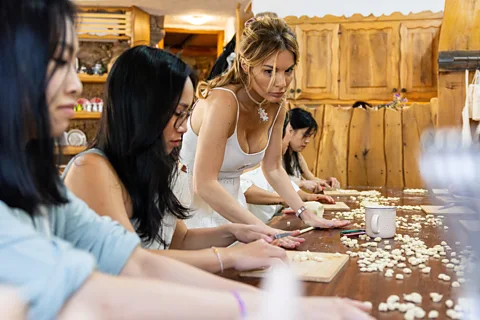 Nb2 Studios
Nb2 StudiosSimonetta Bazzu teaches tourists to make traditional Sardinian pasta, but her biggest dream is to help young Sardinians love their island and its traditions.
There I was, sitting on a plush white sofa in a centuries-old stone house in the abandoned, 400-year-old Sardinian village of Battista. The house was a traditional stazzu (a granite dwelling common to farmers and shepherds in this north-eastern part of the island), and despite having stood empty for more than 40 years, a careful restoration made it feel as though time had stood still. There was a large stone fireplace, the original wood-burning cooking hearth, original stone flooring and a sleeping platform. Only the flat-screen TV served as a jarring reminder that you can sit in the past while staring at the present.
To get here, I'd followed narrow, tortuous roads perched above cavernous green valleys; a dramatic juxtaposition from the quaint cafes and colourful buildings of downtown Olbia 20km north, or the turquoise beaches and yachts in Porto Cervo further along that same curvaceous route. I saw no people along the drive but had been forced to stop abruptly at one point as dozens of sheep flooded the road, bells clanging wildly.
"That's normal here," said my glamorous hostess Simonetta Bazzu, looking every inch a young, blonde Sophia Loren as she welcomed me into her home. Reassuring, but so far little about my experience with her felt normal. Especially not the fact that she owns 11 rough-hewn, uninhabited stazzus that make up the oldest part of Battista, where many of her ancestors – and her father – were born.
The village became abandoned more than four decades ago when the last of its inhabitants – her 100-year-old grandfather, Salvatore and 95-year-old grandmother, Angelina – lived out the last 10 years of their life in Olbia to be close to modern conveniences not available anywhere near Battista, such as doctors and markets.
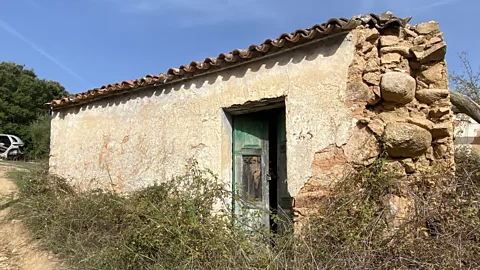 Stefanie Ellis
Stefanie EllisIn a stunning feat of imagination and ingenuity, Bazzu has turned this tiny ghost town into a Sardinian culinary educational centre and pasta school through her brand, Vittoria Arimani, which she launched in 2019. Thanks to the careful restoration work of Bazzu’s father, who owns a construction company, three of Battista's abandoned stazzus have been converted into modern showpieces befitting Architectural Digest – an old goat barn turned into a wine cellar, a one-room stazzu into a pasta and bread museum, and the two-room stazzu, where Bazzu's great-great-grandparents once lived, into a pasta-making kitchen complete with an outdoor wood-burning oven and patio that could double as an upscale restaurant garden.
Bazzu's noble goal: to teach Sardinia's younger generation how to make the bread and pasta their ancestors made – for free – so the traditions can live on.
World's Table
BBC.com's World's Table "smashes the kitchen ceiling" by changing the way the world thinks about food, through the past, present and future.
Lucky tourists like me are secondary beneficiaries of that vision, as Bazzu finances her work through the paid experiences she offers every day, year-round, inviting guests from all over the world to roll pasta on her gorgeous handmade kitchen table. Between the more tourist-driven months of May and October, she offers two classes a day – a lavish lunch or dinner with fruit and vegetables from her garden, baked goods, homemade cheese and wine and more history than one would expect to find in a traditional cooking school.
Sitting on the patio for lunch that day, I could hear birds singing and a lone dog barking in the distance. There are just five neighbours in the area, making the sounds of the past feel much louder than anything in the present.
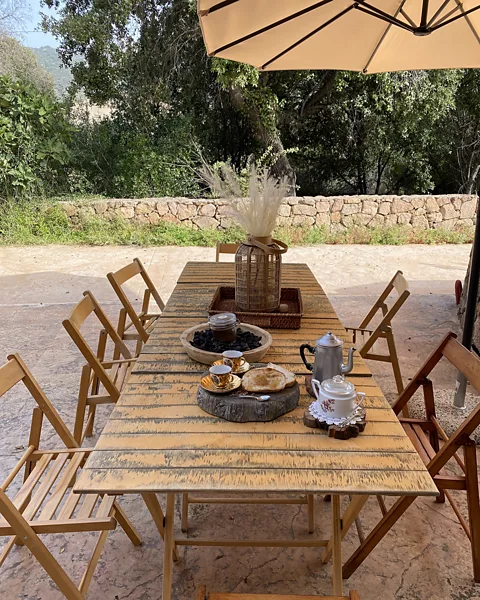 Stefanie Ellis
Stefanie EllisThat most certainly included the food, which Bazzu presented to me as a sort of historical dinner theatre, offering the foundational ingredients from her island in each course. Rose petals were strewn across a tree trunk used as a serving platter, and wedges of crusty bread were spread with homemade lemon marmalade and dusted with a powder she made from dried orange peel.
Into tiny golden porcelain cups, she poured coffee made from acorns she boiled, roasted and ground. It was burnt and nutty in the most delicious way, and she told me her grandmothers drank this, along with coffee made from chickpeas and barley.
"In times of famine, we used what the land could give," she said. "And before there were airplanes, it wasn’t easy to bring sugar, coffee, tobacco or chocolate to Sardinia. My ancestors used honey, almonds, lemon, orange, semolina, barley and acorns."
The island's bounty is staggering. Bazzu told me that in Oliena alone – a village of just 7,000 people in Sardinia’s central-eastern Nuoro province – 37 different almond varieties have been discovered.
"In Sardinia, we have more than 1,200 different types of bread," she added, "and more than 200 different types of pasta – including filindeu, a sacred pasta that not everyone can make."
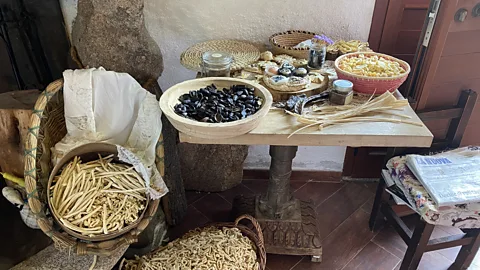 Stefanie Ellis
Stefanie EllisBazzu learned to make filindeu and other ancient foods from living in small villages on different parts of the island over the last decade, studying bread and pasta making with the older matriarchs. I poured myself more coffee as I watched her crush walnuts from her home garden with a brick she found in the dirt. Soon, the nuts were whirring in a blender, along with water and Pecorino cheese, to finally be poured onto a bowl of Maccarones de ferrittu – a pasta from the Barbagia region in the centre of Sardinia named for the iron knitting needles from which they were traditionally shaped. They looked like doughy cigarettes after we rolled them by hand on the table her father made from an old tree.
As I brought a glass of her homemade wine to my lips, I asked why she built all this, and she began to cry.
"I love my island, but life in Sardinia is very difficult," she said. "We are a beautiful island, but we are in the middle of the sea. In the winter, we have just two flights a day, and the boat is very expensive, so if we have wind, we have no boat and no flights. We have many problems. When I cry it's because it’s hard."
"Too many young people go to other cities for work," she added. "I wanted to change the situation in Sardinia and show our history to the whole world."
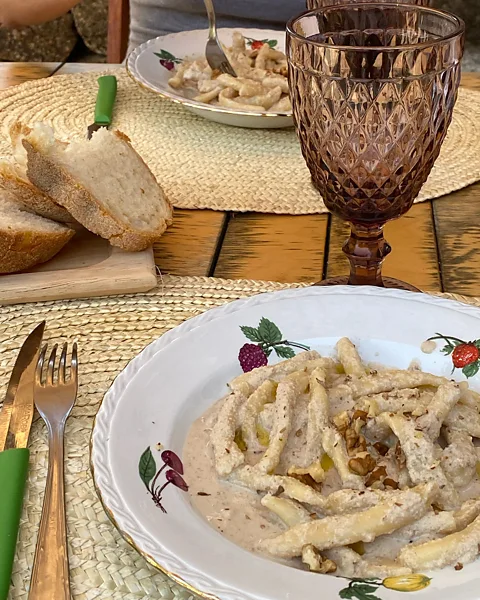 Simonetta Bazzu
Simonetta BazzuHer mission to inspire young Sardinians to connect with their heritage while educating outsiders about the value of supporting its gastronomic economy was initially met with a lack of understanding.
More like this:
• The battle over Italy's eclectic, handbuilt village
After earning a law degree in Milan and managing her father's construction company for 14 years, she says it was difficult for her father to understand why she would choose to make pasta instead of continuing to work with him. "For my father, to make pasta and cheese was to live, not for a hobby or occupation," she said.
Because of this, Bazzu started with no money or support, catering to tourists who spoke English, which she did not know how to speak at the time.
"It was very, very difficult,” she said. "My parents didn't help me when I started. People asked, 'why do you choose this work? Why do you make pasta?' Slowly, people started to understand my work and my mission with younger people in Sardinia.
To get the word out about her mission, she often chats to strangers on the street. As we strolled through the alleys of downtown Olbia one afternoon, she stopped a man wearing a chef's jacket as he was entering his apartment. He was stunned when he learned he could train with Bazzu for free. It's her hope that this kind of enthusiasm creates a ripple effect that will imbue younger Sardinians with pride in their heritage. She also hopes they can build on it by putting their own stamp on things, as Bazzu does.
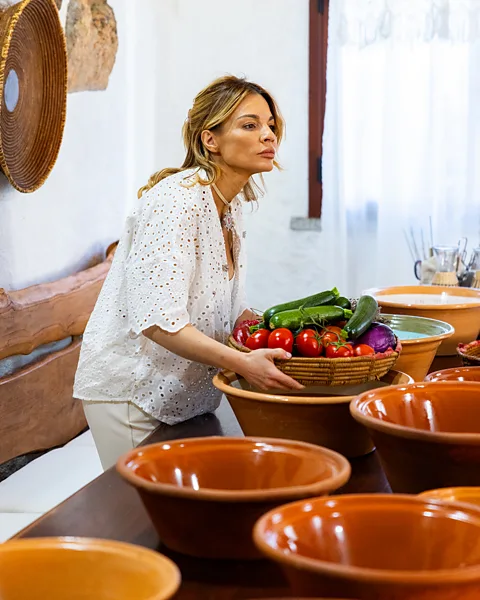 Nb2 Studios
Nb2 Studios"I am younger and love Chanel and disco, but I love to make pasta and cheese," she said. "I love my tradition, but I am modern. God chose me to show the world that Sardinians are also part of the younger tradition."
After many years, she's finally been recognised for the impact her work has had on her fellow islanders. In 2022 she was asked to appear on Stanley Tucci’s show, Searching for Italy – where she pulled a bubbling tray of zuppa cuato – a traditional Galluran dish of thin, crisp Sardinian flatbread layered with lamb broth, local cheese and wild mintfrom her wood-fired oven – while donning stilettos and a low-cut green floral dress with a thigh high slit that might make the island's numerous centenarians (and her ancestors) blush.
When Tucci remarked that it resembled lasagna, she referred to it as "Sardinian lasagna" that doubles as a "hidden soup" because the broth is absorbed, giving the dish a remarkably rich flavour.
Now a de facto spokesperson for Sardinia's culinary riches on international television, she has also been featured regularly in Sardinian newspapers L’Unione Sarda and La Nuova Sardegna. And while inspiring future generations and catering to the many tourists who have come through her kitchen over the last five years, you'd think the success would have gone to her head. But that's not Bazzu's style. She's only got her grandmothers to impress, and knows that wherever they are, they'd be proud to see her carrying on their legacy. Especially in stilettos.
"This isn’t an easy job, but it’s my happiness," she said. "I live today, like my grandmothers yesterday. I have gratitude for my land, and just want people to know the real Sardinia."
--
If you liked this story, sign up for The Essential List newsletter – a handpicked selection of features, videos and can't-miss news, delivered to your inbox twice a week.
